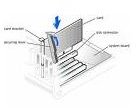Install New Video Card or Upgrade to Vista First - Windows Vista Video Card Installation
Installing a new video card in a Vista computer
If you added additional RAM memory to an existing Vista computer system to get improved performance and only got a noticeable, but hardly exciting new computing experience, then the next logical step is to install a new, higher performance video card.

If the video card currently installed in the computer is an old model built for the likes of XP, it will probably significantly reduce Vista’s operating speed and lack the power to run the Aero interface with its transparent windows, sidebar and images. To address this, desktop computer owners can easily install a new video card to rev up Vista’s graphics power in order to benefit from Vista’s more power-hungry features. The following section should help you identify the kind of video card your computer supports and to install a new video card on your computer.
Installing a video card in a desktop computer is basically the same for every model. They are installed in one of the provided expansion slots on your computer’s motherboard and provide the video output port that connects to your display’s video cable. Before you purchase a new video card however, check your motherboard’s user manual to find out which types of slots are available on your PC.

The majority of desktop computers sold within the last few years have a PCI (Peripheral Component Interconnect) Express slot, which is a dedicated slot for a video card. If you have one of the older PCs mentioned earlier you probably have an AGP (Accelerated Graphics Port) slot or a standard PCI slot. Currently the PCI Express interface provides the best of the three types mentioned here so we suggest you install a PCI Express card, if you can, just to be safe. When you’re selecting the video card you want, keep in mind that the Aero interface requires a video card to meet the specifications of Vista Premium Ready if you want to use all the features

If you want to find out what video cards make the rank, check out Microsoft’s Windows Vista Hardware Compatibility List (www.microsoft.com/windows/compatibility) and look through the database for video cards that are marked “Certified For Windows Vista.”
Before you can remove the old video card, you need to uninstall the drivers for the current graphics processor to make sure there are no conflicts with the new video card’s drivers when you install them. To remove the old driver in Vista, click the Start button, select Control Panel, and click “System and Maintenance.” In the System and Maintenance window, scroll down and click Device Manager, double click the Display Adapters category, and then right-click the old video card. Select Uninstall to remove the video driver from the computer. It’s now ready for the new drivers.
You should always follow the instructions that were included to uninstall the drivers currently on the PC. Turn off the computer and unplug all the cables from your PC. Open the computer’s outer casing and immediately ground yourself (by touching the internal metal frame of the PC) to discharge the static electricity stored on your skin. Before removing the circuit board, you might need to free a small plastic tab that locks the card in place but it should come out pretty easily. Unscrew the metal plate on the card from the computer’s chassis and pull the card straight out of the slot. If you find the computer uses onboard video, which is indicated by the monitor (VGA) connector being in a group of other connectors rather than on a card in a slot, you need to disable the motherboard’s graphics adapter in Device Manager before installing a new card. To do this click the Start button and then select Control Panel, System and Maintenance, and then Device Manager. Right click the video components for on board video and then select “Disable” from the list and you’re ready to install a new video card.
To insert a new video card, line it up directly over the appropriate slot and press firmly until the screw hole in the metal plate lines up with the hole in the PC’s chassis. Close the case on your computer and hook-up the computer’s cables. After the PC’s BIOS (basic input/output system) boots up, the operating system should automatically detect the new card and it should be operational. There’s one last thing: make sure to use the software CD that was included with the new video card to install drivers for the card. Then, just download the newest Vista drivers for your video card from the manufacturer’s website and install them. Your new Vista operating system should purr like a baby.
This post is part of the series: The World of Windows Vista
Welcome to the world of Microsoft’s Windows Vista. Here we will take you through the world of Vista, which is being created day to day by you the user and provide you with information, helpful hints and suggestions on how to use your Vista system better and get more production out of Vista.
- Installing Windows Vista
- Assessing a Computer for a Windows 7 Upgrade
- Tweaking Vista to Improve Performance
- Installing RAM to Improve Vista’s Performance
- Installing a Video Card to Help Vista Perform Better
- Upgrading from XP Home to Vista Home Premium Part 1
- Migrating from Windows XP Media Center Edition to Vista Part 2
- Upgrading from Vista Basic
